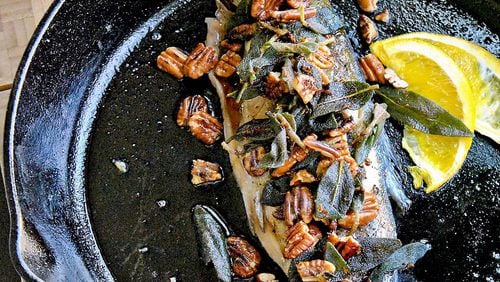It’s spring, and you know what that means: it’s trout fishing season.
Thousands of anglers will be angling for the best fishing spots in local streams and lakes. And the ones who get lucky and land a trout that’s at least seven inches? They’re probably already dreaming of how to cook it.
My husband, who fishes in the Clarion River near Cook Forest State Park, goes for the simplest of preparations. After gutting his prized catch with a penknife (head and tail stay attached), he douses it in bottled Italian dressing, wraps it in foil and throws the fishy package into the coals at the edge of a campfire. Five minutes later, it’s ripe for the picking, and he doesn’t even wait for me to hand him a plate — he eats the roasted flesh right out of the foil, usually with his fingers.
That’s the thing about fresh trout. Its soft and flaky flesh is so wonderfully delicate and fresh tasting, that you don’t have to get fancy with other ingredients. In fact, simpler is often better when it comes to this member of the salmon family.
That’s right, salmon. While the word “trout” conjures up a particular fish, it’s actually the common name given to a number of species of freshwater fish belonging to the salmon family. The brook trout, which is native to eastern North America, is Pennsylvania’s official state fish, but anglers also can catch brown trout, which made its way to colonial America in the 19th century, along with oilier lake trout and the colorful rainbow trout; if they’re ocean-going, the fish are called steelhead.
And if you don’t fish? No problem.
All rainbow trout sold in the U.S., in fact, are farm raised, so there’s no shame in letting the professionals catch it for you.
Trout have a lot of tiny bones, so you will want to ask your fishmonger to remove the backbone or filet it boned, says Henry Dewey, co-owner of Penn Avenue Fish Co. But you may want to cook the trout whole, with its bones still in, because it’s tastier that way, he says.
“Most people just eat around the bones,” he says, after grilling it or panfrying it.
Fresh trout have a nice protective slime on their skin when it comes of out the water, so choose fish that look slippery on the outside, Dewey says. It should also have a nice color and firm flesh.
“Use your animal senses to see if it looks fresh,” he says.
———
PAN-FRIED RAINBOW TROUT WITH CRISPY SAGE AND BROWN BUTTER
PG tested
Fishermen like to get their catch into the frying pan without a whole lot of fuss. This recipe fits the bill in that it’s incredibly easy, both in preparation (all you need is a hot frying pan) and in the list of ingredients (just a handful).
You also can broil it on a foil-lined pan for 4 to 6 minutes, rotating the pan halfway through for even cooking. Or grill it over medium heat for 5 minutes per side. I used orange zest but lime zest would work well, too.
2 1-pound rainbow trout, cleaned
3 tablespoons extra-virgin olive oil
Kosher salt and freshly ground black pepper, divided
8 tablespoons (1 stick) unsalted butter
1/4 cup fresh sage leaves
1 cup pecan halves, toasted
Zest of 1 orange
Preheat cast-iron pan on stove to medium-hot.
Score each trout three or four times per side. Brush with olive oil, and season with salt and pepper.
When pan is hot, lightly brush with olive oil. Place trout in pan skin-side down and cook for 3 minutes, then carefully flip with a thin wide spatula. Cook for 3 minutes more, until fish is opaque. The trout are ready when there are no red spots visible in the cavities of the fish. Remove the trout, cover with foil, and keep warm.
Heat butter in a saute pan over low heat, and cook until the butter turns golden brown. Add the sage and cook until crisp. Add pecans and orange zest, and season with salt and pepper.
Place a cooked trout on each of two warmed plates and top with the bubbling butter. Serve immediately.
Serves 2.
— Adapted from “In the Kitchen with the Pike Place Fish Guys” by the Crew of Pike Place Fish (Avery; 2013)
———
COOKING TIPS
— Trout skin is thin, with tiny scales, so it doesn’t need to be scaled.
— Off-flavors in fats can be easily transferred to trout, so use mild oils for cooking such as butter, peanut or corn oil.
— Cook trout hot and fast, or it will absorb too much fat. For frying, bring the oil to 325 to 350 degrees; for baking, that means a 400- to 450-degree oven.
— Be careful not to over cook! It will toughen the fish. You’ll know it’s done when the flesh flakes easily with a fork and is still moist and tender.
— Store fresh trout in the coldest part of your refrigerator, and use within three days.
— Well-wrapped trout can be frozen for up to two months in a refrigerator freezer and three to four months in a deep-freeze. To thaw, unwrap, place fish in pan, cover, and leave for 24 hours in the refrigerator.
About the Author






